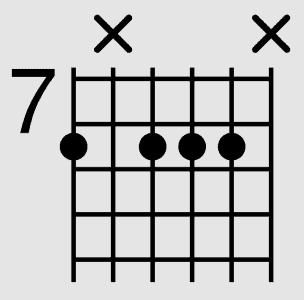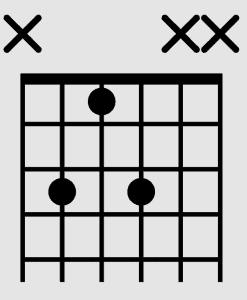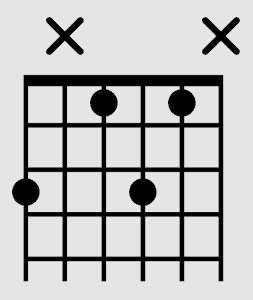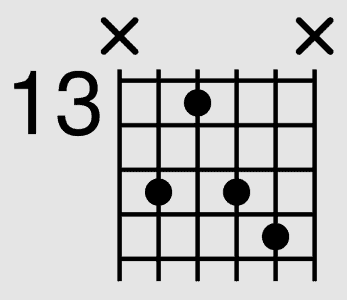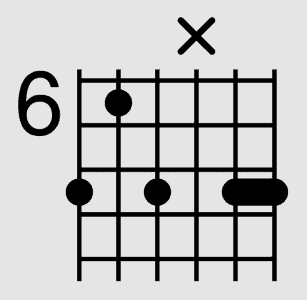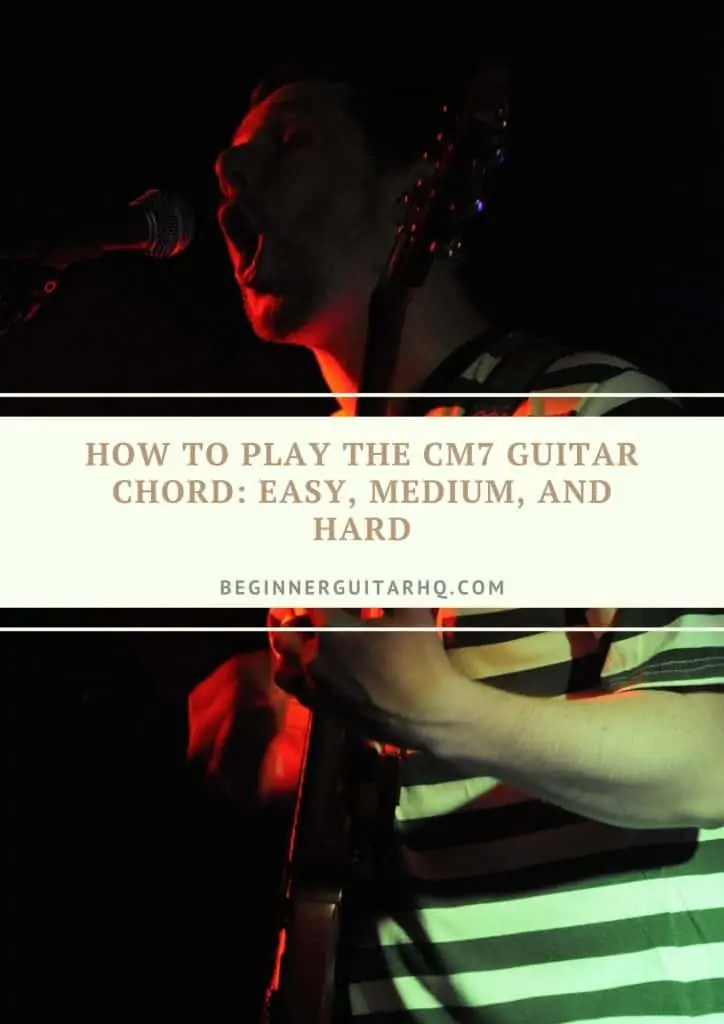The Cm7 guitar chord, like all minor seventh chords, has that beautiful jazzy sound. It’s not to say that minor seventh chords are only present in jazz although you’ll find them there a lot. They just fit in with jazz so well. But you’ll find them in pop, rock, blues, etc. Any time a little extra flavor helps the song along.
We’ll get into a bit of the theory behind Cm7, which is always good to know so you can apply it to other chords and scales you want to play too. It’s also great for seeing exactly how the chord is constructed in different areas on the neck. Don’t worry, I’ll keep it brief.
Then we can get into all the ways to play the Cm7 chord, easy, medium, and hard.
Contents
Cm7 Guitar Chord Theory
Basic chords are made up of triads. This would be the 1st, 3rd, and 5th intervals of the scale it’s taken from. The difference between the C chord and Cm chord is that it has a flattened third, namely, the Eb. The major chord is made up of C, E, and G. The Cm chord is C, Eb, G. Of course, the Cm chord is derived from the Cm scale.
Cm7 is a minor chord with a seventh tacked on to add a little tension. The seventh note as you may have guessed is the seventh interval of the C minor scale:
C-Eb-G-Bb
You’ll find Cm7 in the key of Cm, you’ll also find it in progressions in the key of Ab and Eb too. Sometimes, it’s borrowed from outside the key, for example, playing Cmaj7 and then Cm7 for a bit of intricacy directly afterward.
C Minor Scale
According to the circle of fifths, we can see that Cm has three flats (12 o’clock indicates 0 flats, then the left hand side starts from 1b at the 11 o’clock position, etc): Bb, Eb, and Ab.
I wrote them in that order, because flats (and sharps), always follow the same order: Bb, Eb, Ab, Db, Gb, Cb, Fb. You can use a rhyme to remember the order: Battle Ends And Down Goes Charle’s Father.
The C natural minor scale is as follows:
C, D, Eb, F, G, Ab, Bb
1 2 3 4 5 6 7
So you can see nicely how the notes form the chord with the 1-3-5-7 structure.
The Cm7 Guitar Chord: Easy
Finally, the part you’ve all been waiting for. These are the simplest ways to play Cm7. You will need to skip some strings. If this is the case, mute them by angling your fingers. I put these under easy, because as long as you learn to mute the strings that shouldn’t ring out, you can strum with a pic.
I often prefer to pluck the strings with my fingers since these shapes will work well for this. I only do this when playing fingerstyle or when I use other jazz shell chords.
Cm7 Chord Version 1
You can play this version with two fingers easily. If you prefer to strum, this shape is a good choice. You can try using your thumb to mute the 5th and 6th strings. If you struggle to mute the strings while effectively playing the chord, don’t worry. Regular practice will have you selectively playing the bottom four strings with few errors.
How to Play Cm7 Version 1:
- Index finger: Barre strings 2 and 4, 1st fret (C and Eb respectively)
- Middle or ring finger: 3rd string, 3rd fret (Bb)
- Ring or pinky finger: 1st string, 3rd fret (G)
Cm7 Chord Version 2
While this chord has strings on either side that need to be muted, this isn’t too hard when using your thumb and angling your pinky. It’s missing the G-chord, but goes well with jazz music.
How to Play Cm7 Version 2:
- Index finger: 4th string, 1st fret (Eb)
- Middle finger: 5th string, 3rd fret (C)
- Ring finger: 3rd string, 3rd fret (Bb)
- Pinky finger: 2nd string, 4th fret (Eb)
Cm7 Chord Version 3
This version is the shape that I most like to play for m7 jazz chords. This voicing is higher pitched since it’s all the way in the 8th fret. So I don’t generally play my Cm7 there, but that’s personal preference, I prefer lower voicings. If you love higher voicings, go for it! Again, angle your fingers to mute the strings you need to skip if you’re strumming.
If you’re plucking the strings, you only need use one finger. This is what I do if I’m playing fingerstyle. Otherwise, I use all four my fingers.
How to Play Cm7 Version 3:
If you aren’t going to barre the entire 8th fret with your index finger:
- Index finger: 6th string, 8th fret (C)
- Middle finger: 4th string, 8th fret (Bb)
- Ring finger: 3rd string, 8th fret (Eb)
- Pinky finger: 2nd string, 8th fret (G)
Alternatively, position your index finger as indicated, then barre the other three strings with your ring or middle finger.
The Cm7 Guitar Chord: Medium
These versions of the chord are a little trickier, but will become easier with practice. Depending on your particular mechanics and strength in your hands and fingers,you may find some easier to play than others. You might even wonder what all the fuss is about. But rest assured if they don’t come naturally to you, it’s nothing that regular practice can’t fix.
Cm7 Chord Version 4
This voicing sounds lovely in a jazz progression. The easiest way to play this chord is just using your fingers, that way you only pluck the strings you need to. But I encourage you to angle your fretting fingers toward your high E (1st) string a little so that they touch the strings you shouldn’t play. It’s good practice. This chord is missing the G, but it still sounds good, and you’ll still get that Cm7 sound.
How to Play Cm7 Version 4:
- Index finger: 4th string, 1st fret (Eb)
- Middle finger: 5th string, 3rd fret (C)
- Ring finger: 3rd string, 3rd fret (Bb)
Cm7 Chord Version 5
This barre chord is based on the Am7 open chord shape and uses the root note, C, on the 5th string. Aside from the 6th string, you don’t need to skip any strings. You can easily use your thumb to mute that string and strum away to your heart’s content. If you want to barre the whole fret and play all six strings, not to worry. That will give you an additional G which is nice for adding some bass.
It’s a great alternative if you hate skipping strings in between the active notes and want to stay at the top of the fretboard for a lower voicing.
How to Play Cm7 Version 5:
- Index finger: Barre strings 1-5 in the 3rd fret (G, Bb, C)
- Middle finger: 2nd string, 4th fret (Eb)
- Ring finger: 4th string, 5th fret (G)
Cm7 Chord Version 6
This barre chord uses the root note on the 6th string and is derived from the Em7 open chord shape. It’s a higher voicing given that it’s so high up on the fret board. This works especially well on electric guitars. It’s all about preference here. It sounds great on an acoustic guitar too, especially if someone else is playing the lower voicing.
If you’re playing the same thing as someone else, it’s hard not to feel superfluous. This way, you can still play the same chord, but at the higher pitch, it adds another layer to the music. This version of the chord is also good if you tend to struggle with letting all the strings ring clearly when you’re barring the strings. But learning the correct angle and getting your hand up to strength will sort that out anyway.
How to Play Cm7 Version 6:
- Index finger: Barre the entire 8th fret (C, Eb, Bb, C from 1-6)
- Middle or ring finger: 5th string, 10th fret (G)
- Ring or pinky finger: 2nd string, 11th fret (Bb)
Cm7 Chord Version 7
This barre chord is almost the same as the previous one, just instead of the additional Bb you have an additional G. It still sounds great, you just need to see which one you prefer.
How to Play Cm7 Version 7:
- Index finger: Barre the entire 8th fret (C, G, Eb, Bb, C from 1-6)
- Middle or ring finger: 5th string, 10th fret (G)
Cm7 Chord Version 8
You’ll recognize that this chord is similar to version 1, but with a twist. That little twist is enough to change the sound of the chord to include a little more bass. If you can manage to barre with your ring finger too, you might have an easier time of it. But it’s still pretty easy to do it using three fingers instead of two. It’s much easier to mute the strings that way too. If you struggle with muting the strings you need to skip, it’s a good shape for fingerstyle guitar.
How to Play Cm7 Version 8:
- Index finger: Barre strings 2-4 (C, Eb)
- Ring finger: Barre strings 3-6 (Bb, G)
Alternatively:
- Index finger: Barre strings 2-4 in the 1st fret (C, Eb)
- Ring finger: 6th string, 3rd fret (G)
- Pinky finger: 3rd string, 3rd fret (Bb)
Cm7 Chord Version 9
With this chord shape, only the top two strings need to be muted making it much easier. Because of this, it will have a higher pitch. The higher note on the high E string also lends a little sweetness. You can use either three fingers or all four to play this chord depending on what’s easier for you.
How to Play Cm7 Version 9:
- Index finger: 2nd string, 4th fret (Eb)
- Middle finger: 4th string, 5th fret (G)
- Ring finger: 3rd string, 5th fret (C)
- Pinky finger: 1st string, 6th fret (Bb)
Cm7 Chord Version 10
This shape can feel a bit awkward in the wrist, so play around with the angle a bit and use this chord sparingly if the feeling persists. You want to keep your joints healthy so you can play for many years to come.
How to Play Cm7 Version 10:
- Index finger: 5th string, 6th fret (Eb)
- Middle finger: 6th string, 8th fret (C)
- Ring finger: 4th string, 8th fret (Bb)
- Pinky finger: 2nd string, 8th fret (G)
Cm7 Chord Version 11
This barre chord is almost the same as version 6, but instead of the Bb on the 2nd string, you’ll be playing Eb on the first string. It adds a higher pitched note in there that will work well for some variation in picking or strumming.
How to Play Cm7 Version 11:
- Index finger: Barre the entire 8th fret (C, Eb, Bb, G, C from 1-6)
- Middle or ring finger: 5th string, 10th fret (G)
- Ring or pinky finger: 1st string, 11th fret (Eb)
The Cm7 Guitar Chord: Hard
For some of you, these chords are probably better placed in the intermediate category. But depending again on what your hands can manage, they may be tougher. If you struggle with these shapes, don’t give up. Practice consistently. If you really can’t manage, there’s nothing wrong with using the easier chords. If the music sounds good, who cares.
Cm7 Chord Version 12
This voicing is harder to play mainly because it’s right down the bottom of the neck. It starts in the 13th fret and ends in the 16th fret. Those of you with bigger hands might find it easier than those with smaller hands since the neck is thicker at the bottom.
A cutaway guitar shape will work best since you can angle your hands optimally. On my dreadnought guitar doesn’t work well for me when playing this low on the neck. The leverage just isn’t there.
How to Play Cm7 Version 12:
-
Index finger: 4th string, 13th fret (Eb)
- Middle finger: 5th string,15th fret (C)
- Ring finger: 3rd string,15th fret (Bb)
- Pinky finger: 2nd string, 16th fret (Eb)
Cm7 Chord Version 13
This shape is the same as version 10, just with an extra note on the 1st string. You’ll need to use your pinky to barre the first and second string. For some of us, that is just not something our pinkies were born to do. I often look at my double-jointed husband in envy. If you have longer fingers, it will also be a boon. Sometimes it’s not a case of being able to bend your joints like crazy, sometimes it’s about area covered.
How to Play Cm7 Version 13:
-
Index finger: 4th string, 13th fret (Eb)
- Middle finger: 5th string,15th fret (C)
- Ring finger: 3rd string,15th fret (Bb)
- Pinky finger: Barre strings 1 and 2 in the 8th fret (C and G respectively)
Cm7 Chord Version 14
I didn’t put this one under the hard category because it’s difficult to make that shape with your fingers. It’s because muting the 2nd string can take some doing, especially if you have skinnier fingers.
How to Play Cm7 Version 14:
- Index finger: Barre strings 3-6 (Eb, Bb, C)
- Middle or ring finger: 5th string, 10th fret (G)
- Ring or pinky finger: 1st string, 11th fret (Eb)
Conclusion
Now you’ve got a bunch of ways to play the Cm7 guitar chord and some of them are fairly easy. Master those first and then go onto the harder shapes. Practice makes perfect, as long as you do it consistently. Your muscle memory will soon kick in and you’ll be playing them without a problem soon enough.
Happy jamming!

Cheanné Lombard lives in the home of one of the new Seven World Wonders, Cape Town, South Africa. She can’t go a day without listening to or making music.
Her love of music started when her grandparents gave her a guitar. It was a smaller version of the full-sized guitars fit for her little hands. Later came a keyboard and a few years after that, a beautiful dreadnought guitar and a violin too. While she is self-taught when it comes to the guitar, she had piano lessons as a child and is now taking violin lessons as an adult.
She has been playing guitar for over 15 years and enjoys a good jam session with her husband, also an avid guitarist. In fact, the way he played those jazzy, bluesy numbers that kindled the fire in her punk rock heart. Now she explores a variety of genres and plays in the church worship group too and with whoever else is up for a jam session.



